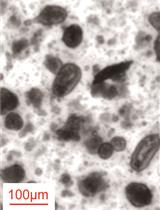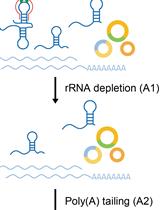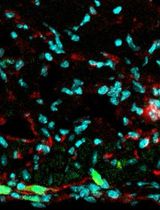- EN - English
- CN - 中文
Ex vivo Culture Assay Using Human Hair Follicles to Study Circadian Characteristics
通过人类毛囊体外培养研究昼夜节律特征
发布: 2020年06月05日第10卷第11期 DOI: 10.21769/BioProtoc.3638 浏览次数: 3859
评审: Alessandro DidonnaYu-Jui ChiuBenjamin Housden
Abstract
Ex vivo culture assays of biopsy specimens are advantageous for the experimental evaluation of human circadian characteristics. We developed a simple and non-invasive experimental evaluation method for monitoring the expression of circadian clock genes in an ex vivo culture assay using human hair follicles. This method imposes little burden on subjects. This assay is useful for validating correlations between circadian characteristics in hair follicles and intrinsic characteristics observed in physiological and behavioral studies. While they should be further validated, this ex vivo method constitutes a useful tool for estimating in vivo circadian characteristics.
Keywords: Circadian rhythm (昼夜节律)Background
Living organisms exhibit circadian rhythms in physiology and behavior that are driven by the circadian clock (Young and Kay, 2001). The circadian clockwork consists of cell-autonomous and clock gene-driven negative feedback loops of transcription (Dunlap, 1999). In mammals, the transcription factors BMAL1 and CLOCK activate the transcription of clock and clock-related genes such as Period (Per) and Cryptochrome (Cry) via E-box elements. PER together with CRY, a potent transcriptional inhibitor, subsequently functions to negatively regulate this complex (Reppert and Weaver, 2002). The in vivo evaluation of individual intrinsic circadian characteristics in humans, either with a constant routine or forced desynchrony protocol, is expensive and labor-intensive. Therefore, evaluation using ex vivo culture assays to estimate in vivo circadian characteristics could present important advantages. For example, several studies have concluded that circadian characteristics in peripheral cells reflect individual circadian preferences, known as chronotype (Brown et al., 2005; Hida et al., 2013). For a simple and non-invasive evaluation of cell-autonomous circadian performance in humans, including intrinsic period length, we developed a method to monitor clock gene expression in real time using an ex vivo culture of hair follicles (Yamaguchi et al., 2017).
Materials and Reagents
- (Optional) Keep-warm bag
- Sterile sampling tubes (the volume size should be within 0.2 from 1.5 ml) (e.g., 0.2 ml tube, Bio-Bik, catalog number: 133003 ; 1.5 ml tube, VIOLAMO, catalog number: 1-1600-1 )
- 35 mm dishes (e.g., IWAKI, catalog number: 1000-035 )
- DMEM without Phenol Red (Sigma-Aldrich, catalog number: D2902 )
- DMEM (Nacalai, catalog number: 08456-94 )
Although DMEM from other suppliers is usable as a substitute for these DMEMs, the possibility cannot be excluded that the difference in concentrations of minor ingredients affects success rates and results slightly. - Sodium bicarbonate (Sigma-Aldrich, catalog number: S8761 )
- HEPES (Nacalai, catalog number: 17557-94 )
- D-Glucose (Sigma-Aldrich, catalog number: G8769 )
- Penicillin/streptomycin (Thermo Fisher Scientific, catalog number: 15070-063 )
- L-Glutamin (Nacalai, catalog number: 16948-04 )
- Sodium pyruvate (Sigma-Aldrich, catalog number: S8636 )
- Luciferin (WAKO, catalog number: 126-05116 )
- Silicone (Shin-Etsu, catalog number: KS-64 )
Note: Reagents #6-13: Similar items from other suppliers serve as a substitute. - Adenovirus vectors carrying the luciferase (luc) gene driven by circadian promoter/enhancer elements (e.g., Bmal1-luc, Per2-luc and Per3-luc). Some entry vectors we constructed and deposited are available from the RIKEN bank as follows:
RDB15083 mouse Period2 (-2.8 ~ +0.1 kb) - Luciferase/pENTR-1A
RDB15084 human Period3 (-3.1 ~ +0.2 kb) - Luciferase/pENTR-1A
RDB15085 human Bmal1 (-1.7 ~ +0.1 kb) - Luciferase/pENTR-1A
The ViraPower Adenoviral Gateway Expression Kit (K4940-00, Thermo Fisher Scientific) is required to generate adenoviruses using these entry vectors. Procedures using adenoviruses must be performed inside P2 areas. Autoclave and discard any infectious wastes - Infection medium (see Recipes)
- Pre-incubation medium (see Recipes)
- Rinse medium (see Recipes)
- Luciferin-containing medium (see Recipes)
Equipment
- Non-slip, cosmetic-use tweezers (e.g., Shiseido, eyebrow nippers 211)
- Tweezers (e.g., FST, catalog number: 18132-12 )
- Block incubator set to 36.5 °C (e.g., ASTEC, model: BI-516C )
- Laminar flow cabinet (e.g., SANYO, model: MCV-B131F )
Note: Equipment #1-4: Similar items from other suppliers serve as a substitute. - Incubator at 35-36.5 °C with 5% CO2 (e.g., ASTEC, model: SCA-165DRS )
Use a CO2 incubator that utilizes an infrared sensor that is not affected by humidity inside the chamber (see details in Procedure Step 18). - Photomultiplier tube (Hamamatsu, model: LM2400 )
- Luminescence microscope (Olympus, model: LV200 )
Software
- Cosinor software (freely downloadable from a website: https://www.circadian.org/softwar.html)
Procedure
文章信息
版权信息
© 2020 The Authors; exclusive licensee Bio-protocol LLC.
如何引用
Nishida, A., Miyawaki, Y., Node, K. and Akashi, M. (2020). Ex vivo Culture Assay Using Human Hair Follicles to Study Circadian Characteristics. Bio-protocol 10(11): e3638. DOI: 10.21769/BioProtoc.3638.
分类
细胞生物学 > 基于细胞的分析方法 > 基因表达
发育生物学 > 细胞信号传导 > 睡眠
您对这篇实验方法有问题吗?
在此处发布您的问题,我们将邀请本文作者来回答。同时,我们会将您的问题发布到Bio-protocol Exchange,以便寻求社区成员的帮助。
提问指南
+ 问题描述
写下详细的问题描述,包括所有有助于他人回答您问题的信息(例如实验过程、条件和相关图像等)。
Share
Bluesky
X
Copy link












